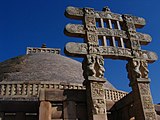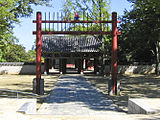
Kusatsu Onsen Sainokawara Park, Gunma Prefecture Source: Wikimapia
In folklore, there is a famous River of the Dead called Sai-no-kawara, (there are actual varying physical locations in Japan), the most famous one being perhaps Kusatsu’s Sainokawara Park (see photo gallery below).
















According to tradition, here it is Jizo Bodhisattva, the most beloved and well-known of folk deities, who is the guide for the lost souls of children on the Sai-no-kawara riverbank, and who saves them from either the Oni (ogre-demon) or Shozuka-no-baba (see photo of her enshrined), the Hell’s Hag who receives the souls of the dead, and wife of Ten Datsu-Ba (source: Mythology Dictionary). She demands money from all who arrive at her home on the bank of the River of Three Roads (River Sanzu) and, if it is not paid, takes their garments…one version of the story is found in the folktale “Broken Images“:
“I am Jizo, who guards the souls of little children. It is most pitiful to hear their crying when they come to the sandy river-bed, the Sai-no-kawara. O dreamer, they come alone, as needs they must, wailing and wandering, stretching out their pretty hands. They have a task, which is to pile stones for a tower of prayer. But in the night come the Oni to throw down the towers and to scatter all the stones. So the children are made afraid, and their labour is lost.”

Beloved Jizo is saviour of the children and whose counterparts in Central Asia are Sraosha (Persia), Ksitigharba(India) and Jizhang(China).
In the tradition of Japan’s Pure Land sects, when a child dies, its soul has to cross the River Sanzu (Sanzu No Kawa 三途の川, River of Three Roads, River of Three Crossings, akin to the River Styx in Western myth), which lies between the first and second Judges of Hell (between the kings Shinkō-ō and Shokō-ō; see above). It is believed that when a person dies, they can cross the river at three different spots depending on how they lived their lives. After the first trial by Judge Shinkō-ō, the dead who are found innocent can cross the river, walking on a bridge guided by Jizō. The guilty, however, must swim across deep waters and the less guilty ford across a rapid stream. On the other side of the river, the old Hell’s Hag Datsueba waits for the guilty to arrive and then robs them of their clothes. Those who arrive without their clothes are instead stripped of their skin.
Since children have not accumulated enough experiences, however, they are unable to cross. At the river’s edge, the souls of deceased children are met by the Hell’s Hag or Datsue-ba himself (and not the wife of Ten Datsu-Ba)who strips the clothes off the children, then hangs them on a tree to measure the weight of their sins. How far the tree bends determines where they are allowed to cross the river. Datsu-ba advises them to build a pile of pebbles on which they can climb to reach paradise. But before the pile reaches any significant height, the Hell’s Hag and other underworld demons maliciously knock it down. The Buddhist bodhisattva Jizō saves these souls from having to pile stones eternally on the bank of the river by hiding them in his robe and guiding them across the river to safety. Datsue-ba is sometimes described as the wife of Yama, King of the Dead.
When a soul is that of an adult, Datsue-ba forces the sinners to take off their clothes, and the old-man Keneō hangs them on a tree branch and measures the gravity of the sins. If the sinner arrives with no clothes, Datsue-ba strips them of their skin. Various levels of punishment are performed even at this early stage. For those who steal, for example, Datsueba breaks their fingers, and together with her old-man consort, she ties the head of the sinner to the sinner’s feet (Source: Wikipedia’s Datsue-ba).
Datsueba (also Datsue-ba), spelled either 奪衣婆 or 脱衣婆. The characters 脱衣 literally mean to undress, to “take off one’s clothes,” or to “stripe one of one’s clothing.” Datsueba makes her first appearance in Japan in the Bussetsu Jizō Bosatsu Hosshin Innen Juō Kyō 仏説地蔵菩薩発心因縁十王経, a late Heian-era Japanese sutra (based on a Chinese counterpart) dealing with Jizo Bosatsu and the Ten Kings of Hell, but Sanzu no Baba 三途の婆, Shōzuka no Baba, and Jigoku no Baba 地獄の婆 likely appeared much earlier. The Sainokawara at Kusatsu, Gunma is associated with the Shirane Jinja Shrine nearby which according to local legend is dedicated to the mythical prince, Yamato Takeru (recorded in the Kojiki and Nihonshoki Chronicles) and who allegedly discovered Kusatsu Onsen.
This landscape has elements that appear to have close affinity to Indo-Iranian/ Persian ideology and the Netherworld hell’s hag and other attendant characters likely came from a westerly region of China where either Persian Zoroastrians, Saka- or Zoroastrian Sogdians resided in great numbers and influenced Taoist ideas. The Sogdians are also known to have dominated the trade along the Silk Route from the 2nd century BCE until the 10th century CE (see Sogdian Trade). In Japanese folklore, Shozuka-no-baba, the hell’s hag cast in opposition to Jizo, reminds us of Druj nasu (or Nasu) the female corpse demon who in Persian mythology is in opposition to Sraosa or Sraosha, guardian of the underworld, the ear that heard the cries of man and, a judge (along with Mithra) who weighed souls in the scales in the underworld of death. This demon was said to cause the corruption of corpses, in some accounts described as taking the shape of a fly which crawls over a corpse as soon as a soul leaves its body (source: “Persian Mythology” entry in the Mythology Dictionary).
Zoroastrian tradition considers a dead body—to be nasu, unclean, polluting. The nasu corpse demon was believed to rush into the body and contaminate everything it came into contact with. The pile of stones in the Shozuka-no-baba landscape reminds us of the funerary tower of the Zoroastrians as well as of the cairns built by semitic peoples or of the cairns of Central Asian and Eurasian landscapes, such as the ovoos of Mongolia, Tibet, Yunnan(Southwest China) and the Russian Baikal area. The Vendidad (an ecclesiastical code “given against the demons”) has rules for disposing of the dead as “safely” as possible, and the bodies of the dead are placed atop a dahkma—a tower of silence—and exposed to the sun and to scavenging birds, so that “putrefaction with all its concomitant evils… is most effectually prevented.”[Source: Brodd, Jefferey (2003). World Religions.] In another Japanese myth Izanami and Izanagi, Izanagi escaped the demons of hell by throwing peaches at them, and upon escaping from the Land of Yomi, had to perform purification ritual ablutions to cleanse himself of the pollutants from the land of the putrefying dead. In ancient times, peaches were cultivated in the cline from Southwest China to Persia (see Golden Peaches of Sarmarkand), and peaches and peachwood were popular in China as charms against disease demons and evil spirits (see Chinese Peach Charms). Peach wood was also used to make swords, arrows, and amulets in ancient times because the Chinese word for peach (tao 桃) has the same pronunciation as the Chinese word for “flee” or “run away” (tao 逃) (see Chinese Peach Charms). Peaches are fruit which the Chinese legends associate as fruit of immortality grown in garden by Xiwangmu the Queen Mother of the West (which suggests a western foreign origin of the goddess and of the peaches). Magic wands of the taoist priests were made of peach wood are used in exorcisms. (River Sanzu, the River of the Japanese underworld sounds somewhat like Shazu, which is a Persian river-god.)

Statues of Jizo Bosatsu at the Kusatsu Onsen Sainokawara Park (Photo source: Wikimapia)
Kangaroo Notebook; by Kobo Abe, translated by Maryellen Toman Mori. In the novel, it is said there are 164 Riverbank of Sai sites in Japan, a description is given many of the locations are listed at this page.
The Nagatoro Funadama Festival held annually on the Arakawa River in the Chichibu area of Japan in Saitama prefecture is but one example among many, of ancient river or water expulsion practices still practised today in Japan. The Nagatoro Fireworks festival is held right beside the river, preceded by sending off a boat lit up with lights. The festival takes place during the Bon period, to honor the spirits of the dead that visit the realm of the living during this period. After dark, boats decorated with paper lanterns and about 1,000 individual lanterns are floated on the waters of the Arakawa River to pray for the repose of drowned persons, creating an otherworldly atmosphere. Click here to watch a video clip of the event or read more about the Festival for the Dead here.
Pottery with faces painted in black ink have been excavated from the Mizutare archaeological site of Nagaoka Palace in Kyoto Prefecture.
Archaeologists have also found fragments of earthenware jars that had been tossed into a dried-up riverbed of a tributary of the Yamatogawa River (in today’s Yao city, Osaka) in a ritual to bring salvation and ward off illness. Distinctive faces had been painted in black ink on the small pottery jars. Along with the pottery jars, seven types of coins were discovered, along with Kocho-Junisen copper coins from the Nara (710-784) period (as well as Kangen-Taiho coins minted in the 958 which suggests the practice continued through the early Heian (794-1185) period).
Below is an excerpt from the Encyclopedia of Religion that is particularly illuminating on the widespread and connected ideas and cosmology behind the “river of Death” in various ancient cultures, particularly in the Indo-European/Indo-European/Aryan cultures, that spread to Japan.
“RIVERS OF DEATH. Crossing the river at the time of death, as part of the journey to another world, is a common part of the symbolic passage that people have seen as part of one’s journey after death. In the Epic of Gilgamesh, the hero encounters a boatman who ferries him across the waters of death as he seeks the secret of immortality. The river Styx of Greek mythology is well known as the chief river of Hades, said to flow nine times around its borders. Styx is married to the Titan Pallas and according to Hesiod counts as her children Rivalry, Victory, Power, and Force. The power of the Styx is evidenced in the fact that Achilles gained his invulnerability by being dipped in the river as a baby held by his heel, the only part of his body thereafter vulnerable to mortal wounds. In addition, the most inviolable oath of the gods is sworn with a jug of water from the Styx, poured out while the oath is being uttered.
In Hindu mythology, the river Vaitaran: marks the boundary between the living and the dead; in the Aztec journey, the river Mictlan must be crossed on the way to the underworld; in Japan, rivers are part of certain landscapes designated as realms of the dead in both the Shinto¯ and Buddhist traditions. The Sanzunokawa, for example, is said to divide the realms of the living and the dead. The dry riverbed of Sainokawara is said to be the destination of dead children.
The far shore of the river of life and death, or birth and death, thus becomes an important symbol for the destination of one’s spiritual journey in many religious traditions. In the Buddhist tradition, nirva¯n: a is referred to as the “far shore.” In the Hindu tradition, holy places are called t¯ırthas (“fords”) because they enable one to make that crossing safely. Riverbank t¯ırthas, such as Banaras and Prayaga, are thought to be especially good places to die. In the Christian tradition, crossing over the Jordan has come to have a similar symbolism. On the far shore is not only the promised land, but the spiritual promised land of heaven. Home is on the far shore…”
Source and references:
Encyclopedia of Religion (2nd edition) ed. Lindsay Jones, pps. 7862
The Nara Court practised harae purification rituals by the river (Heritage of Japan website)
Common symbols in Eurasia-Pacific unconsious cultural heritage: A case study of the Taiwanese 17 Deities’ cult” by Igor Sitnikov
The Vedic Age, 1500-500 B.C. throws light on the Indo-Aryan system of sacrificial priesthoods, and culture of sacrifice and purification rituals that became all pervasive and that came to dominate and influence the nomadic cultures of the Eurasian steppelands as well much of Central Asian civilization where the Indo-Aryans invaded or interacted with.
” … more and more magnificent royal sacrifices were performed–the most famous being the rajasuya, which was initially repeated every year, and the asvamedha, the horse sacrifice. In the later the king’s horse was allowed to roam for a year and then the king claimed the land the horse had transversed. The major sacrificial rituals were occasions for the consumption of wealth, extending over many months with lavish libations of milk and clarified butter, ghi, the offering of grains and the sacrifice of the choicest animals in the herd. These rituals testified that the king had met all challenges or that no one had dared to challenge him. These ceremonies would remain central to Indian cults of kingship for another thousand years, influencing medieval kingship as it developed.
Kings would perform purification rituals which would give them power as sacrificers, the patrons of the sacrifice. As I mentioned, these rituals were said to place the raja in the proximity of the gods–gradually the kings came to be seen as divinely appointed. The gods had titles incorporating sovereighty, paramountcy and overlordship, and as a consequence of the ceremonies the rajas became eligible for such titles. A king was seen, for example, as Indra the chief of the gods. The rituals gave the king–the chief sacrificer among sacrificers–responsibility for maintaining cosmic order and fertility. Since the chief sacrificers also added to the status and significance of sacrificial priests, brahmins were active proponents of this exhalting of the status of kings. Kings and brahmins continued their mutual interest in preserving their positions.
Brahmins received patronage from a stable kingship and the king protected their superial status, their monopoly on purity. Only brahmins could learn the hymns and mantras and only brahmins had the right to perform certain purifying rituals and exercises.
The immigrating Aryans had not encountered mighty enemies and big empires–such as in Persia. Thus they were not forced by events to develop political units which would allow for more effective military capacity, to seize and protect territory–as did the Aryans in Persia, where they developed imperial organization early. On the contrary, the proliferation of little kingdoms, the janapada, in the western Genges Valley was a political luxury which the Aryans could afford; they could afford to remain decentralized…”
In the early Vedic texts rajas are shown as having to consult a council of all male members of a tribe or aristocratic tribal councils called sabhas or samitis. Some tribes had no kingly figures and only councils–these were aristocratic tribal republics, a kind of cheifly organization, or gana-sanghas …. In the early Vedic age, as I mentioned earlier, presiding rajas were elected. A new type of raja appears, however, in the late Vedic period, after the transition to settled agriculture and the more complex society which developed. This raja became more of a king, one who emerged from a power struggle among the nobility and then was ritually invested by brahmin priests. A political system in which there were a number of little kings developed into a system whereby there were fewer kings and these had more authority. Still, these more powerful figures did not have well-developed royal administrations. Instead, more and more magnificent royal sacrifices were performed–the most famous being the rajasuya, which was initially repeated every year, and the asvamedha, the horse sacrifice. In the later the king’s horse was allowed to roam for a year and then the king claimed the land the horse had transversed. The major sacrificial rituals were occasions for the consumption of wealth, extending over many months with lavish libations of milk and clarified butter, ghi, the offering of grains and the sacrifice of the choicest animals in the herd. These rituals testified that the king had met all challenges or that no one had dared to challenge him. These ceremonies would remain central to Indian cults of kingship for another thousand years, influencing medieval kingship as it developed.
Druj Nasu is according to Persian mythology a “corpse demon that takes possession of the dead in the form of a fly. Known as Druj Nasu. In Zoroastrian funerary rites, the corpse is washed and dressed, and then taken by corpse bearers to the dahkma (“Tower of Silence”), a massive, circular funerary tower on elevated ground where the Zohr i atash proper occurs, involving the pouring of animal fat upon a fire, representing the ancient animal sacrifices that were used to appease Druj i Nasu, the corpse demon. Further, this ritual is seen to assist the soul on its heavenly journey, which begins on the fourth days after death. Bareshnum i-no Shab was necessary of all Zoroastrians, and, even now, most devout Zoroastrians undergo the rite at least once in their lifetimes. (See also Daevas)
Sacred Expression- Stone Cairns by Cynthia Morin




















 Shime torii: just two posts and a shimenawa
Shime torii: just two posts and a shimenawa Shinmei torii
Shinmei torii
 Myojin – kusagi and shimaki are curved upwards
Myojin – kusagi and shimaki are curved upwards Kasuga torii /myōjin torii with straight top lintels cut at a square angle
Kasuga torii /myōjin torii with straight top lintels cut at a square angle



























































































 Stone chamber of the Kitora Mound
Stone chamber of the Kitora Mound
